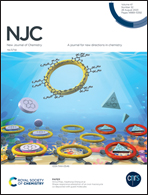Ni-doped Al2O3 sensor for effective SO3 gas adsorption and sensing†
Abstract
Ni-doped alumina nanoflakes are a potent sensing material for SO3 gas at 20–90 °C with moderate recovery. Herein, an economical synthesis of undoped and doped alumina for the experimental detection of SO3 target gas is reported. The Ni-doping results in an efficient fast response to all tested concentrations of the target gas and also showed good response at room temperature. However, the response increases enormously with the increase in temperature and reaches saturation at higher temperatures. Among the different temperatures, the sensor delivers a huge response at 90 °C and this temperature is optimum for sensor operation. The high Ni-doped sensor reveals an improved response of 12.40 towards 10 ppm SO3 and a response time of 9 s. The response shows a two-fold increase up to 60 ppm. The stability of the Ni-doped sensor is evaluated and validated under the ageing test over a 5 week period. Surprisingly, the sensor response shows a feeble decrease, maintaining an immense response. The sensor demonstrates ∼97% reproducibility, which assures the possibility for practical applications. Meanwhile, the Ni-dopant helps to increase oxygen adsorption and active sites.



 Please wait while we load your content...
Please wait while we load your content...